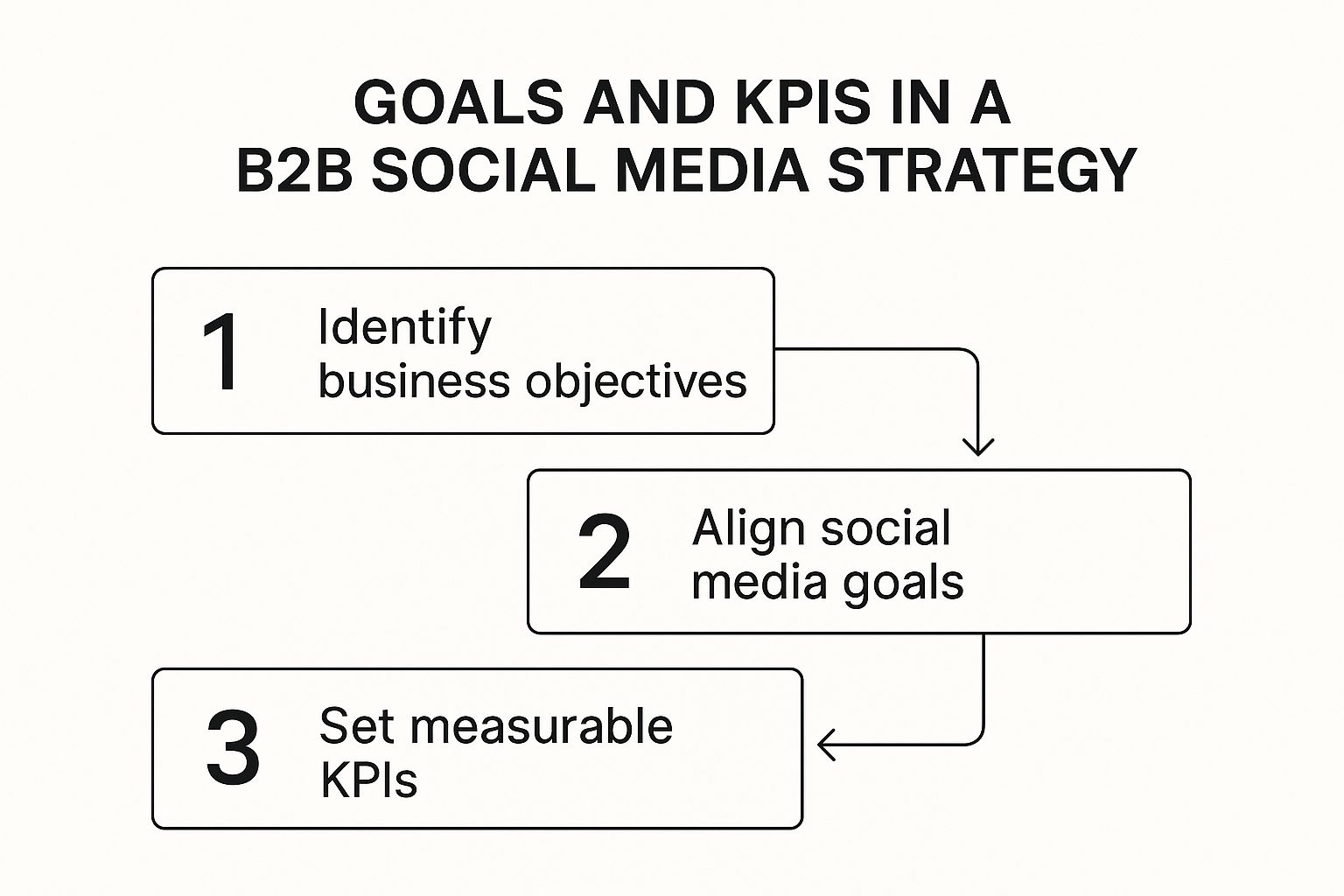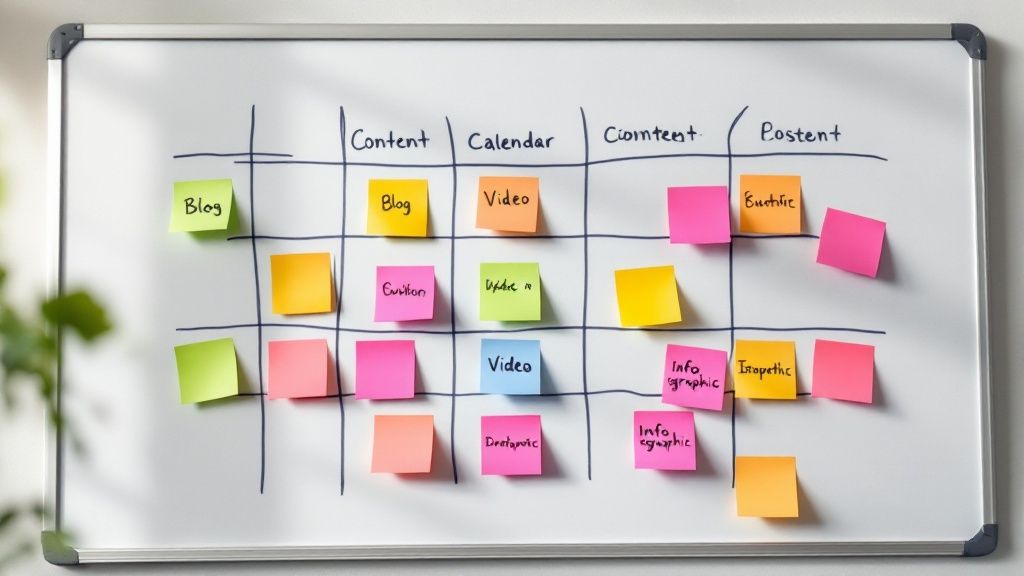Let's be honest: the old B2B social media playbook is broken. Simply showing up, repurposing a few blog posts, and broadcasting company news won’t cut it anymore. Today's B2B buyers are savvy—they use social media to research vendors, evaluate your expertise, and seek genuine human connection long before they consider making a purchase.
A modern social media strategy for B2B is much more than a presence. It’s a sophisticated, data-informed approach that uses multiple platforms to build relationships, generate qualified leads, and establish your brand as the authority in your field. The goal is to create meaningful connections with decision-makers throughout a long and often complex sales cycle.
Crafting a Modern B2B Social Media Strategy
Welcome to the definitive guide on building a B2B social media strategy that drives business results. Forget the generic advice. We're diving deep into what works right now to connect with decision-makers who expect real value and expertise from the brands they follow.
This guide will walk you through the core components of a successful strategy, packed with actionable insights you can implement immediately.
Before we get into the details, let's look at the foundational pillars that support a strong, modern B2B social media plan. Think of these as the essential building blocks that ensure your efforts are targeted, consistent, and ultimately, measurable.
Core Pillars of a Modern B2B Social Media Strategy
PillarKey ObjectiveCore ActivityAudience UnderstandingGo beyond demographics to deeply understand your buyer's professional world.Create detailed buyer personas mapping out challenges, online habits, and information needs.Strategic Platform SelectionBe present where it matters, not everywhere.Identify the specific channels where your ideal clients are most active and receptive.Value-Driven ContentEducate, inform, and solve problems first; sell second.Develop content that establishes your company as a trusted, go-to authority in your field.Performance MeasurementMove beyond vanity metrics to track real business impact.Monitor KPIs that tie directly to business goals, like lead quality and sales pipeline contribution.
Building your strategy around these pillars helps you avoid the common mistake of treating B2B social media like its B2C counterpart. It’s a different game with a different set of rules.
The Foundation of B2B Social Success
An effective social media strategy is built on this solid foundation. Let's briefly touch on why each of these pillars is non-negotiable.
Deep Audience Understanding
This isn't just about knowing job titles and company sizes. It's about getting inside your buyers' heads. What are their biggest professional challenges? Where do they go online to find solutions? What kind of content would make their jobs easier? Creating detailed buyer personas is your first, most critical step.
Strategic Platform Selection
Don't spread your resources thin trying to be everywhere. That’s a recipe for burnout and mediocre results. Instead, focus your energy on the platforms where your ideal clients are genuinely active and open to business-related conversations. For most B2B companies, that means a heavy focus on LinkedIn, but don't discount niche forums or professional communities.
Consistently Value-Driven Content
Your content has one primary job: to serve your audience before it serves your brand. The ultimate goal is to educate, inform, and solve problems so effectively that your company becomes the go-to resource in your industry. When people trust your expertise, they are far more likely to buy from you.
Meaningful Performance Measurement
A strategy without metrics is just a collection of hopeful guesses. You need to track KPIs that connect directly to your business objectives. Forget obsessing over follower counts. Instead, focus on metrics like lead quality, website traffic from social, and social media's contribution to the sales pipeline.
B2B social media is a long game. Unlike consumer marketing, which often chases quick, impulse buys, the goal here is to build trust and credibility over time. Each post, comment, and interaction is a small deposit into a relationship that can lead to significant long-term value.
By building on this framework, you can transform your social channels from passive broadcasting tools into active engines for business growth.
Defining Your B2B Social Media Goals and Audience
Every solid B2B social media strategy starts by answering two deceptively simple questions: What are we trying to achieve, and who are we talking to?
Without clear answers, you're just creating noise. Your efforts will feel random, and you'll have no way to know what's working and what's a waste of time. The first step is to look past vanity metrics like follower counts and build a plan that drives tangible business results.
Your social goals can't exist in a vacuum. They need to be a direct extension of your broader business objectives. If your company is focused on increasing market share, a smart social media goal might be generating a specific number of qualified leads or boosting brand awareness in a new industry.
Aligning Goals with Business Objectives
You must connect your social media activity to concrete business outcomes. Vague goals like "increase engagement" are not enough. Instead, get specific with SMART objectives—Specific, Measurable, Achievable, Relevant, and Time-bound—that directly contribute to revenue or brand equity.
For example, a software company wanting more product demos could set a goal to generate 50 qualified leads from LinkedIn in the next quarter. It’s specific, measurable, and ties directly to a sales outcome.
This process is a straight line, connecting your high-level business goals all the way down to the specific metrics you track daily.

As you can see, KPIs aren't just arbitrary numbers. They are the final, tactical piece of a strategy that starts with your company's core mission.
To put this into action, you'll need to define Key Performance Indicators (KPIs) for each goal. These are the hard numbers you’ll use to measure success.
- For Lead Generation: Track the click-through rate (CTR) on posts with lead magnets, form submissions from social, and your cost per lead (CPL).
- For Brand Authority: Monitor your share of voice, mentions from industry leaders, and the engagement rates on your thought leadership content.
- For Website Traffic: Use UTM parameters consistently to track landing page visits and conversions that originate from a specific social media campaign.
Creating Detailed B2B Buyer Personas
Once you know what you're aiming for, you need to get crystal clear on who you're talking to. A B2B buyer persona is a semi-fictional sketch of your ideal customer, built from market research and real data about the people who already buy from you. This goes beyond a simple job title.
A useful persona delves into the details of their professional life—their challenges, motivations, and goals. It’s not just "a Marketing Manager at a tech company." It’s knowing this manager is struggling to prove ROI on her campaigns, feels overwhelmed by new technology, and scrolls through LinkedIn for practical advice from peers who've solved similar problems.
Here’s how you can build these profiles:
- Interview Your Best Customers: Ask them about their daily work, what keeps them up at night, and where they turn for industry news and insights.
- Talk to Your Sales Team: They are on the front lines and possess incredible, unfiltered insights into customer pain points and common objections.
- Use Social Listening: Pay attention to conversations on platforms like LinkedIn and X (formerly Twitter). What problems is your target audience openly discussing?
Your content should feel like a direct answer to a question your ideal customer is already asking. A well-defined persona makes this possible by shifting your focus from "what we want to say" to "what they need to hear."
The sheer scale of the global social media landscape makes this targeted approach non-negotiable. With over 5.4 billion users worldwide and the average person using nearly 7 different networks monthly, a one-size-fits-all strategy is destined to fail.
A CFO seeking financial insights on LinkedIn has entirely different needs than a creative director searching for inspiration on Instagram. With social ad spending projected to hit $276.7 billion by 2030—and 83% of that on mobile—your content must be designed for someone scrolling on their phone.
Ultimately, understanding why social media marketing is important justifies this foundational work. When you combine measurable goals with a deep, empathetic understanding of your audience, you create a rock-solid base for everything you post.
Choosing Your Battlegrounds for Maximum Impact
Not all social media platforms are created equal, especially in the B2B world. A classic mistake is treating platform selection like a checklist—trying to be everywhere at once. This "spray and pray" approach is a fast track to burnout and mediocre results. An effective social media strategy for B2B requires being selective and concentrating your resources where they will make a difference.
Your goal is to find the digital spaces where your ideal customers are already seeking solutions, reading industry news, and having professional conversations. It's about meeting them on their turf, not shouting from yours and hoping they’ll find you.

This decision must be backed by data, tying directly back to the buyer personas and business goals you've already mapped out. Consider the unique culture and content format of each platform. A technical deep-dive that performs well on LinkedIn would fall flat as a TikTok video.
LinkedIn: The B2B Powerhouse
For the vast majority of B2B companies, LinkedIn is the undisputed heavyweight champion. It's the only major platform built from the ground up for professional networking, making it the most fertile ground for connecting with decision-makers.
When over 85% of B2B marketers cite it as their most effective channel, it's essential to pay attention. The platform's culture is centered on career development, industry insights, and professional problem-solving—a perfect environment for your expertise to shine.
Consider a B2B SaaS company specializing in cybersecurity. They can use LinkedIn to:
- Share in-depth articles about emerging security threats.
- Post case studies showing how they helped a client prevent a data breach.
- Run targeted ads to reach Chief Information Security Officers (CISOs) at specific companies.
The key to LinkedIn is demonstrating authority. It's less about flashy visuals and more about substantive, valuable content that helps professionals do their jobs better.
The real power of LinkedIn lies in its precision. No other platform lets you target users with such granularity based on their job title, industry, company size, and professional interests. This makes it an indispensable tool for lead generation and account-based marketing.
X (Formerly Twitter): The Real-Time News Hub
While LinkedIn is for deep dives, X excels at real-time conversation and breaking news. It serves as the digital water cooler for many industries, where trends emerge and leaders share quick, unfiltered thoughts. For B2B, it’s an excellent channel for building brand personality and participating in timely industry discussions.
A financial technology firm could use X to:
- Live-tweet key takeaways from a major industry conference.
- Share quick commentary on new market regulations.
- Engage directly with journalists and analysts covering their space.
Success on X is all about being nimble and conversational. You have to add value to existing conversations, not just broadcast your own messages into the void.
Evaluating Other Potential Platforms
LinkedIn and X are often the main pillars, but other platforms can play powerful supporting roles, especially when you consider return on investment (ROI). Data on perceived ROI from B2B social media marketing highlights both Facebook and LinkedIn as key players. One survey found that 22% of B2B marketers see Facebook delivering the highest ROI, while another showed 70% of marketers trust LinkedIn for positive returns. You can explore more insights about social media marketing ROI statistics to see how different platforms compare.
Here’s a quick breakdown of how to approach other channels:
PlatformBest ForContent FormatsAudience VibeYouTubeIn-depth product demos, tutorials, and expert interviews.Long-form video, educational series, customer testimonials.Users seeking detailed, visual explanations and "how-to" content.FacebookBuilding communities and running highly-targeted ad campaigns.Video, live streams, community posts in Groups, detailed event pages.A broader demographic, often highly engaged within specific niche groups.InstagramHumanizing your brand and showcasing company culture.Short-form video (Reels), behind-the-scenes Stories, high-quality images.Visually-driven users, effective for employer branding and reaching younger professionals.
Your platform mix should be a living part of your strategy. Start with one or two core channels where you know your audience lives. Master them, measure your results, and only then should you consider expanding. It’s far better to dominate one platform than to be a ghost on five.
Crafting a High-Value B2B Content Plan

Content is the fuel for your B2B social media engine. But let's be clear: simply dusting off old blog posts and sharing them on LinkedIn won't be enough. To win over today's sophisticated B2B buyers, your social media strategy for B2B needs a deliberate content plan built on delivering genuine value, not just filling a quota.
The primary goal is to consistently share insights that make your audience's jobs easier. You want to become an indispensable resource they can't afford to ignore.
This requires a mental shift—stop selling and start advising. Your content should address your audience's most urgent questions and biggest frustrations, offering a clear path forward long before they're thinking about your product. When you prioritize genuine problem-solving, you build the kind of deep trust that closes deals down the line.
The Three Pillars of B2B Social Content
To keep your feed fresh and effective, build your content plan around three core pillars. Think of these as different conversation starters that attract, engage, and convert your ideal customers at various points in their journey. Each pillar serves a specific purpose.
- Thought Leadership: This is your top-of-funnel content that establishes credibility. This includes original research, bold industry predictions, or unique takes on emerging trends. The goal is to make your audience see their challenges in a new light and position your brand as a leader.
- Educational Guides: This is where you get practical. This pillar is about actionable advice—think "how-to" carousels, quick video tutorials, and downloadable checklists that solve a specific pain point. It's how you prove your expertise in a tangible way.
- Behind-the-Scenes Content: It's time to humanize your brand. Share stories about your team, offer a glimpse into your company culture, or highlight customer success stories. This content builds an emotional connection by showing the real people behind the logo.
By building a calendar that balances these three pillars, you create a varied, engaging feed that avoids becoming monotonous. This mix appeals to everyone, from high-level executives looking for strategy to practitioners seeking tactical tips. You can explore more detailed strategies for improving your social platforms to see how this fits into a bigger picture.
From Big Ideas to Bite-Sized Posts
One of the biggest hurdles in B2B social media is the constant need for high-quality content. The secret is to get smarter about repurposing your most valuable assets. A single, in-depth webinar or whitepaper can be a content goldmine, easily providing dozens of smaller social posts.
Think of it as a content pyramid. At the top sits your "pillar" asset—a major piece of content like an annual industry report. From that one piece, you can extract a wealth of smaller, social-native content.
Don't just publish and forget. Every major content asset should be viewed as a campaign in itself, with a plan to break it down into multiple social-native formats that extend its life and reach over several weeks or even months.
For instance, a single 45-minute webinar could be repurposed into:
- A series of short video clips highlighting key takeaways.
- A LinkedIn carousel summarizing the main points.
- Quote graphics featuring powerful insights from the speaker.
- An X (formerly Twitter) thread breaking down one specific concept.
This "create once, distribute many" model is a massive time-saver. More importantly, it ensures your channels are consistently populated with high-value content drawn from your best work.
Mastering B2B Content Formats
The game has changed. B2B social media is no longer about just dropping links to your blog. It’s about strategic, authentic messaging delivered in the right format. Currently, short-form video is an absolute powerhouse, with 35% of social media marketers naming it as the format with the highest ROI.
This trend points to a broader industry shift toward dynamic, attention-grabbing formats. While detailed articles still have a home on platforms like LinkedIn, your content plan must embrace visual and interactive formats to succeed. Carousels are fantastic for breaking down complex ideas into digestible steps, and a good infographic can make data-heavy topics far more engaging and shareable.
The key is to match the format to both the platform and the message. When you get that right, you maximize your impact.
Measuring Your B2B Social Media Success

An excellent social media strategy for B2B is only half the story. If you aren't measuring your performance, you're essentially flying blind. You have no way to know what's driving actual business results versus what’s just creating online noise. The real power comes from analyzing the data and letting it guide your next move.
This means you must look past the easy, surface-level metrics. Sure, watching your follower count climb feels good, but vanity metrics don't pay the bills. The game is about connecting your social media activity to tangible business outcomes, proving its value, and constantly refining your approach for better results.
Identifying the B2B Metrics That Matter
To know if you're succeeding, you need to track the Key Performance Indicators (KPIs) that align with the business goals you set from the start. A SaaS company focused on lead generation will care about completely different numbers than a consulting firm aiming to build its reputation as a thought leader. Your KPIs are your North Star—they tell you if you're on the right path.
Let's break down the essential metrics into a few key groups.
- Awareness Metrics: This is your top-of-funnel view. It tells you how many people see your content. While not the end goal, it’s a vital sign of your brand's reach.
- Impressions: The total number of times your content was shown on a screen.
- Reach: The number of unique people who saw your post.
- Engagement Rate: The percentage of people who saw your post and interacted with it (likes, comments, shares).
- Amplification Rate: This measures how much your followers are helping spread the word. It's the ratio of shares per post to your total follower count.
- Click-Through Rate (CTR): The percentage of viewers who clicked the link in your post.
- Cost Per Lead (CPL): If you're running ads, this tells you exactly how much you spent to acquire one new lead.
Remember, the metrics that truly count are the ones that tell a story about business impact. A high CTR is nice, but a high CTR that leads to qualified sales opportunities? That’s what defines B2B success.
Connecting Social Activity to Revenue
Ultimately, every B2B social media strategy must prove it's delivering a positive return on investment (ROI). This can be challenging, especially with long B2B sales cycles, but it’s absolutely doable with the right tracking in place. You're essentially following the path from the first social interaction to a closed deal.
This involves seeing how leads from social media channels move through your sales pipeline. When you integrate your social media analytics with your Customer Relationship Management (CRM) system, you can pinpoint which platforms are not just bringing in leads, but bringing in leads that become paying customers.
For a deeper dive, our complete guide on measuring social media ROI will walk you through setting up a robust tracking framework.
Essential Tools for B2B Social Analytics
You can’t manage what you don’t measure. Trying to track all of this manually is a surefire way to burn out. Fortunately, there are many powerful tools that can gather, analyze, and report on your performance with incredible precision.
Here are a few must-haves for any serious B2B marketer.
Tool CategoryExample ToolsPrimary FunctionPlatform-Native AnalyticsLinkedIn Analytics, X AnalyticsProvides foundational data on reach, engagement, and followers straight from the source.All-in-One Management ToolsSprout Social, AgorapulseOffers comprehensive dashboards to schedule, monitor, and create detailed reports across multiple platforms.Social Listening ToolsBrand24, BuzzSumoHelps you monitor brand mentions, competitor activity, and emerging industry trends.Website AnalyticsGoogle Analytics 4Crucial for tracking how much traffic social media is sending to your website and what those users do once they arrive.
Using a mix of these tools gives you a 360-degree view of your performance. This setup allows you to graduate from simple reporting to a cycle of continuous improvement, where data from one campaign informs and improves the next.
Frequently Asked Questions
When you're deep in the trenches of a social media strategy for B2B, some questions inevitably arise. Even experienced marketers hit roadblocks that need a clear answer. This section tackles those common queries with practical advice to help you sharpen your approach.
Think of this as your quick-reference guide for the tricky spots, ensuring your strategy stays on point and drives business.
How Long Does It Take to See Results?
This is perhaps the most common question, and the answer is always: be patient. In the B2B world, social media isn't about chasing impulse buys. You're playing the long game—building trust and establishing yourself as an authority.
You will likely see early indicators, like increased engagement or follower growth, within the first 1-3 months. However, the results that truly move the needle—a steady stream of qualified leads and a measurable impact on the sales pipeline—typically take 6-12 months of consistent effort. Every valuable post and genuine interaction accelerates that process.
B2B social media is a marathon, not a sprint. The goal is to build a foundation of trust with prospects over a prolonged sales cycle. Consistent value delivery is the only shortcut.
What Is the Most Important B2B Platform?
For nearly any B2B company, LinkedIn is the undisputed heavyweight champion. It’s built for professionals, its targeting capabilities are incredibly powerful, and its entire ecosystem is centered around industry expertise. This is where your decision-makers are actively looking for solutions.
That said, the best platform is always where your audience is. A smart social media strategy for B2B usually starts with a solid LinkedIn presence and then expands based on data.
- If your buyers follow real-time industry news, X (formerly Twitter) becomes your go-to for quick insights and joining conversations.
- If your product requires a visual deep-dive or a how-to, YouTube is essential for demonstrating its value.
The key is to not make assumptions. Let your audience research be your guide.
How Can I Measure Social Media ROI?
Measuring ROI in B2B social media is about connecting the dots between your activity and business outcomes. You must look past vanity metrics like likes and shares and track how your social efforts translate into revenue. A robust tracking system is the only way to do this effectively.
The first, non-negotiable step is using UTM parameters on every link you share. This simple action allows you to trace website traffic and conversions back to specific channels and campaigns within Google Analytics.
From there, you need to track a few key metrics:
- Cost Per Lead (CPL): Calculate how much you are spending—in both time and ad dollars—to acquire a single lead from each platform.
- Lead Conversion Rate: What percentage of visitors from your social channels complete a desired action on your site, such as filling out a form or downloading a guide?
- Social-Sourced Pipeline: This requires collaboration with your sales team. Tag every lead in your CRM that originated from social media. This allows you to see how many of them become qualified opportunities and, ultimately, closed deals.
Suddenly, ROI is no longer a fuzzy concept; it's a hard number you can include in a report.
Should My Company Use Newer Platforms Like TikTok?
I hear this question more and more, and my answer is a firm "it depends." While platforms like TikTok remain overwhelmingly consumer-focused, some B2B brands have found a niche there, particularly those targeting younger professionals or in more creative fields.
Before you jump in, ask yourself two honest questions:
- Do we have proof that our ideal customers are on this platform and are receptive to business content here?
- Does the informal, fast-paced, trend-heavy style of the platform align with our brand's voice?
For most B2B companies, especially those in traditional industries like finance or manufacturing, platforms like TikTok should be treated as an experiment at best. Master the platforms where your audience is already proven to be—like LinkedIn—before you venture out.
Ready to stop guessing and start driving real business growth with your social media? The experts at Twelverays craft data-driven B2B social media strategies that deliver measurable results, from lead generation to pipeline growth. Discover how we can build a plan tailored to your unique goals. Learn more about our B2B social media services.





